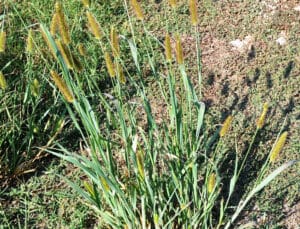Dr. Patricia J. Vittum, entomologist
University of Massachusetts
Description
Many people have been asking me what the impact of the severe cold of this recent winter will be on our turf insect populations. I think it is still too early to tell (because there is still snow on the ground, even though yesterday marked the official start of “spring”). Nevertheless, here is what I see through my crystal ball:
White Grubs overwinter as large larvae and move downward through the soil profile as temperatures begin to drop in the fall. They return to the root zone in the spring to feed for a few weeks (usually late April and May) before pupating. Normally they have plenty of time to move downward ahead of the frost. If you are in an area that experienced a very sudden deep freeze in November or December before there was snow on the ground, you MIGHT experience slightly lower numbers of grubs this spring, but I doubt it.
Invasive Crane Flies (leather jackets) overwinter as large larvae but do not move down deep in the soil profile. Instead, they remain in the top two to four inches of the soil. They must have figured out a way to adapt to our Northeastern winters, because there are some very robust populations in western New York, which normally experiences even colder temperatures than we see in southern New England. Crane Flies are able to respond to local conditions and even feed on turf during the winter when temperatures turn mild (above 35º F) for a few days. (We did have a brief thaw in January, which might have been enough to enable the larvae to nibble a little.) Again, for those who have had snow cover continuously since December, my guess is that the insect survival will be quite high.
Winter Cutworms overwinter as large caterpillars and are similar to the crane flies in that they can become active very quickly any time temperatures moderate on the surface. They also can feed under the snow, so if you observe what appears to be new insect feeding damage as the snow recedes this spring, winter cutworms might be the culprits. Again, snow cover would work to the advantage of the cutworms.
Black Cutworms are not able to survive our cold winter temperatures, so they migrate south in the fall and return to the Northeast in the spring. Because the temperatures have been so brutally cold throughout the Eastern Seaboard this year, my guess is that the black cutworms had to move further south than usual this year, and perhaps their survival will be compromised at least a little bit. In addition, it should take them longer to return to the Northeast, because they have further to travel. We can hope, anyway!
Annual Bluegrass Weevils overwinter as adults in protected sites, avoiding the most exposed areas that are subject to desiccating winds. The adults use a form of “anti-freeze” to avoid the worst effects of freezing. If you are in an area that had a sudden deep freeze before the snow cover arrived, there MIGHT be a little weevil mortality, but the little buggers really are very well adapted to our cold temperatures, so it is likely that you will see the same levels you have seen in past years. Their emergence will certainly be later than it has been in past years, because the temperatures so far have been so cold in February and March. The degree of damage we see from the weevils will depend more on the weather conditions we experience in April and early May than what we went through in the winter.
Chinchbugs & Billbugs also survive the winter as adults. As with all the other insects that go through the winter in that stage, they use a form of “anti-freeze” to survive. If their usual hiding places were in exposed areas subject to those desiccating winds, you might see a slight drop in populations this spring. But most places had snow cover for much of the winter, which provided a lovely insulating blanket, so I expect most chinchbug and billbug populations to be relatively unscathed by our recent winter.
It doesn’t seem fair, does it?





